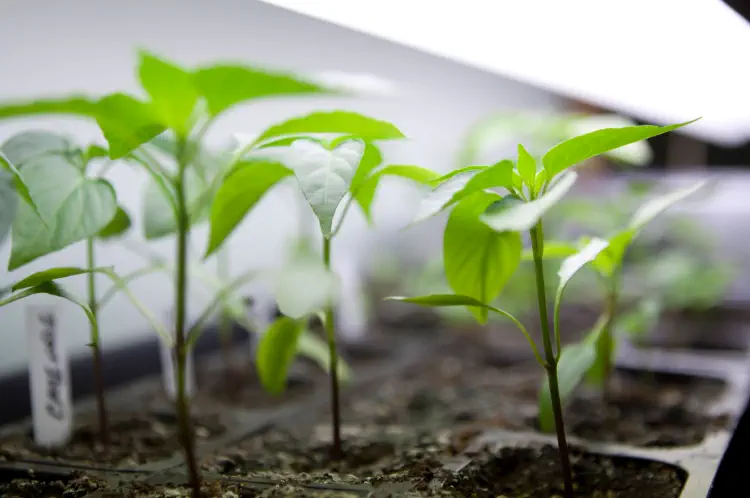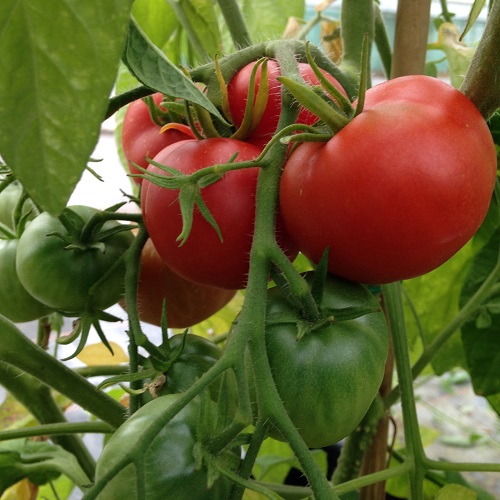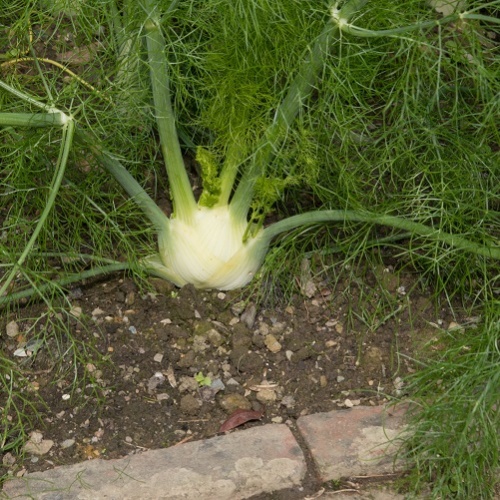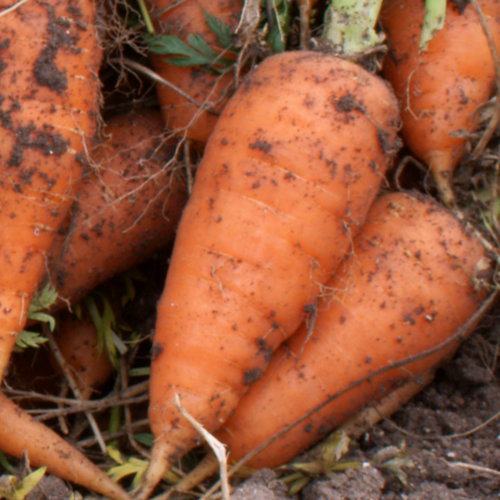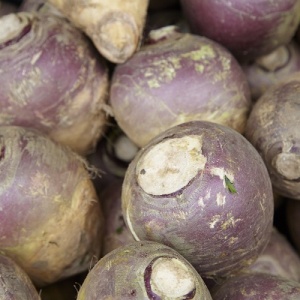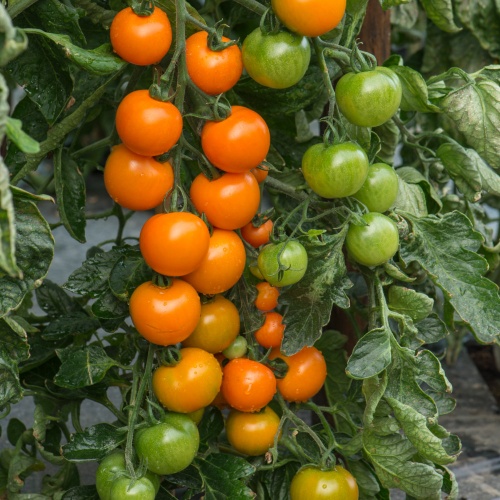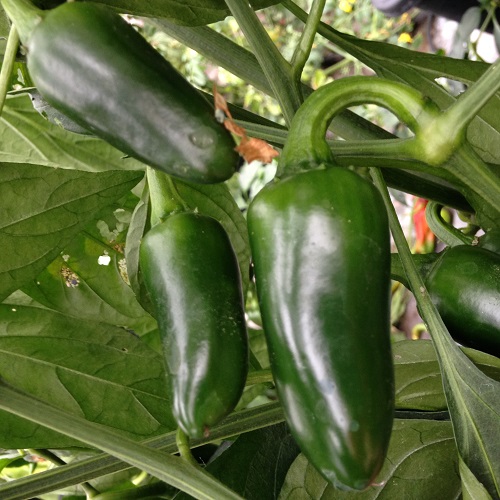Are you trying to decide between hardneck garlic and softneck garlic for your garden? Knowing what's the right variety for you and your garden will help you choose the best option. In this post we’ll go over the differences in growing conditions, flavour profiles and storage to help you decide which one is the preferred choice for you.
How to Feed Plants.
A Beginner’s Guide To Feeding Vegetable Plants
All plants need “food” in order to create sufficient energy, which is required to help them to grow to their full potential. They derive this energy by drawing nutrients and water from the soil and by absorbing Carbon Dioxide (CO2) from the air. Then they convert these elements into food by using sunlight, in a process known as photosynthesis. The green pigmentation, found in leaves and stems contains chlorophyll, which is essential for photosynthesis. The resulting food is glucose and starch, from which plants obtain their energy.
Different plants have different levels of nutrient requirements, most of which they take up from the soil. If the soil is lacking in specific nutrients then this will have a direct effect on the quality and growth rate of the plants together with any subsequent flower and fruit production. Some plants require a high level of Nitrogen, some require more Potassium and some require a high level of Phosphorous. These are known as the main 3 chemical elements that plants require. Others, such as zinc, boron, copper and iron are known as trace elements, which are needed in smaller quantities.
Knowing what food your vegetables need
If plants are grown regularly in the same plot of soil then the nutrient level within the soil will become depleted and the plants will ultimately suffer. That’s why vegetable gardeners will add compost or manure to the soil every year and then perhaps top this up with a granular fertiliser or a liquid feed during the growing season. Because the growing and feeding process of specific plants can be quite complex, produce gardeners only really need to know what their particular plants need in order to produce the best quality vegetables or fruits.
We already know that all plants require a certain amount of Nitrogen, Phosphorous and Potassium (NPK) but if you are a vegetable grower, it’s very useful to know which of your vegetable plants will need more or less of these 3 primary chemicals. So, as a basic guide, Nitrogen is needed to produce healthy leaves and stems, which means it’s essential for leafy vegetable plants, such as cabbage and spinach. Phosphorous is needed for strong root growth, which includes tubers and tap roots, such as carrots and swede, while Potassium aids the growth of fruits.
Nitrogen, Phosphorous and Potassium (NPK)
This is a very general description of the role, in which each chemical element plays a very important part in plant growth. Now, if we look at the role of Nitrogen in more detail, we find that this chemical plays a major part in the production of chlorophyll, which as we know is essential for photosynthesis. Nitrogen is also a major component in amino acids, which forms the basis for proteins. It helps in the storage and distribution of energy, which is why it is known as one of the big three essential elements.
Phosphorous plays a multifunctional role in the growth and development of plants. Root growth is obviously very important, especially for root vegetables but it is also essential in promoting flowering and for quality seed production. Potassium, or Potash as it is sometimes referred to, is the element that helps accentuate a plant species’ characteristics in the form of shape, size, colour and taste. Quite simply, plants cannot grow successfully without the availability of all 3 of these essential elements.
The organic gardener’s preference
Organic gardeners are fully aware of the importance of NPK but prefer to enrich the soil without the use of chemical fertilisers. This is done by incorporating copious amounts of well-rotted vegetation, such as garden compost, or natural animal waste better known as Farm Yard Manure (FYM). The quality of compost will depend very much on its components. For example, a good quality compost will consist of a variety of rotted plant vegetation, which might include mixed vegetables, leaves and stems. General kitchen waste can also be added to the compost heap.
As the vegetation breaks down or rots, it releases its chemical components, which are then recycled back into the soil to feed the next generation of plants. Compost will also very likely contain a large proportion of worms, which are beneficial in aerating the soil. If the compost consisted only of leaves, as in leaf mould or spent mushrooms, as in mushroom compost, then it will have very limited value in terms of nutrient value. This type of compost is best used as a mulch to aid water retention and to supress weed growth rather than a feeding compost.
Manure options to consider
Farm Yard Manure, on the other hand, is rich in essential chemical elements as it will consist mainly of digested and part-digested grass and other vegetation. Most often, FYM will be mixed with straw, which helps to keep it “open” and also helps to bind the matter together, otherwise it would get quickly washed away with rain water. Whichever type of organic matter is used to feed the soil, it’s important that it is well-rotted. Fresh manure or green compost will heat up as it decomposes, which could cause root damage to any tender young plants and seedlings. Organic composted material and well-rotted FYM is best incorporated into the soil in late autumn and left to overwinter.
Another type of manure quite often used by organic gardeners, is “Green Manure”. Unlike typical compost or well-rotted manure, green manure seeds are sown over barren ground and then dug in once the season is over. Basically, you prepare an area of ground that you will not use for growing crops. Then, decide on what type of green manure you need. For example, do you want to improve the soil structure, add nitrogen and other nutrients to the soil or improve drainage? Perhaps all three.
The quick and easy fix option
There are green manure seeds for all types of applications and they include, Yellow Trefoil, Mustard, Phacelia, White Clover, Forage Rye and Fenugreek to name a few. You can of course use a complete mixture of green manure seeds to cover a wide variety of soil issues. This method of improving the soil and adding nutrients is best practised by those who are unable to compost or unable to obtain well-rotted FYM. Green manure is a very safe and effective method of soil fertilisation. The green manure plants are ready to be dug into the soil before they begin flowering, after which new crops can be planted, usually within 30 days.
For those who are unable to create their own compost, obtain FYM or use the green manure option, there is another option, which offers a quick and easy fix. This includes adding chemicals and other additives directly to the soil. General garden fertilisers, such as Growmore are available in granular form and can simply be sprinkled over prepared ground throughout the growing season. These contain the essential elements that plants need to grow but will not improve the soil in any way over the long term. Perhaps a better option would be to apply fish, blood and bone to the soil, which is at least organic in nature.
Liquid and foliar feed options
Fish, blood and bone provides a balanced supply of the essential big 3 elements, which are released slowly, enabling plants to absorb them when needed. Granular fertilisers can be leached out from the soil much quicker during spells of heavy rain. However, organic matter and especially FYM, will release nutrients much slower and over a longer period of time. Many vegetable gardeners tend to incorporate compost or FYM in the autumn and then apply a granular fertiliser sparingly during the early months of the growing season, which seems like a sensible compromise.
When it comes to applying feed to growing plants, and especially vegetables, there are yet two other options to consider. That is, liquid feed and foliar feed. Liquid feeds have been around for a long time and are used both commercially and by the amateur gardener. Applying liquid feed is best restricted to container grown plants as the feed can be readily absorbed before leaching out. Containers provide plants with a limited amount of soil and therefore applying liquid feed regularly during the growing season will prove beneficial.
You get out what you put in
Foliar feeds work because plants are able to absorb nutrients quickly through their leaves. This method can be quite effective when applied to plants that are displaying signs of nutrient deficiency because nutrients can be absorbed quicker through the leaves than through the roots. However, there are some limitations to foliar feeding. Never apply a foliar feed to plants during full sun as this could cause scorching of the leaves. Also, it is easy to over feed using this method, which can also result in permanent foliar damage.
The consensus of opinion among many professional and amateur gardeners alike is that you will only get out what you put in. So, when it comes to growing vegetables, traditional, tried and tested methods of feeding plants are more reliable. As most vegetables are grown in open ground, then it makes sense to work on improving the soil by incorporating plenty of organic matter, which will help improve the soil structure, aid drainage and feed the plants all in one go. Applying a supplementary feed, such as a granular fertiliser or fish, blood and bone, regularly but sparingly during the growing season, will undoubtedly help to ensure plants are not lacking in any essential nutrients.
Now that we have explored the nutrient requirements of plants and all the various types of feeding methods, we’ll now take a closer look at some of the main vegetables grown in the UK, to ensure we understand what they need individually, in order to provide us with a bumper harvest.
Potatoes
Potatoes are classified as tuber crops, which grow underground from the roots of the plant and are used as storage systems. They contain high levels of starch and are highly nutritious. Potatoes are a staple food and considered the fourth most important food in the world, after rice, wheat and maize. Other well-known tuber crops include sweet potato and yams. Potatoes are so popular, they are grown all over the world and fortunately they are very easy to grow. However, getting the best out of your seed potatoes, in terms of a high yield, will depend on how well the plants grow in your garden, your allotment or in your containers.
Although quite a high percentage of the potato plant is above ground, they do not need high levels of Nitrogen. Instead, they need twice as much Phosphorous and Potassium, so a ratio of 5-10-10 of NPK would be ideal. If the feed level was to be high in Nitrogen then the green tops would become soft and lush, making the plants more susceptible to potato blight. A higher level of both P and K will ensure the tubers grow large and healthy. A sprinkling of a potato fertiliser, rated 3-6-6 at planting time will help the plants get off to a good start. Water is the only other necessary ingredient as potatoes are made up of around 80% water.
Carrots
Carrots are classified as root vegetables, alongside turnips, swede and parsnips. They are grown mainly in open ground but can also be grown in deep containers. They prefer a free draining soil, so they will grow better on a light sandy type soil or at least a soil that has been well prepared with plenty of organic matter. A nitrogen-rich soil will cause carrots to fork and split so it’s best to adhere to a low nitrogen feed. A feed that is higher in P and K is best and a ratio of 0-10-10 or 5-15-15 should be ideal.
Phosphorous and Potassium are required to encourage more root development, and this applies to all root vegetables. Bonemeal is a good alternative feed supplement to a general granular fertiliser, which can be added to the soil when the young carrot tops are about 7.5cm high. Also, a potassium-rich liquid feed can work just as well as granular bonemeal. For best results, apply a feed every 2-3 weeks during the growing season. The only other vital ingredient is copious amounts of water. Carrots, like all root vegetables need to be able to absorb nutrients such as P and K easily and regular watering will aid this process.
Peas
Peas will grow best in a soil that has been well pre-prepared with the addition of organic compost. This applies to both open ground situations and large containers. Peas are legumes and like all legumes they can manufacture their own Nitrogen, which they deposit into the soil. That’s the main reason why legumes make such good “Green Manure”. So, if you were to add more Nitrogen to the soil then peas would just produce lots of lush green shoots and plenty of tendrils at the expense of flowers, which are needed in order to produce pods.
If the soil is in good condition and has sufficient organic compost added then no further feeding should be necessary. However, if the soil is poor with little nutrient content then you can add a granular fertiliser that is high in Potassium or Potash. Alternatively, and to increase the yield, use a high Potash liquid feed every week. Water is the only other essential additive needed and especially when the flowers are dying and the pods are just setting.
Runner Beans
Like peas, runner beans are legumes so will fix their own Nitrogen. Runner beans grow tall so they are only suitable for growing in open ground with the aid of long supports or “bean sticks”. Ground that has been prepared well in advance by incorporating plenty of organic matter will produce the best crops. Runner beans are fast growing and will produce a profusion of leaves, stems flowers and bean pods. All this activity requires plenty of energy and so adding a Phosphorus and Potassium-rich fertiliser to the soil when the plants are young will help.
Also, as the flowers begin to appear, applying a liquid feed at every watering will help the plants to produce a virtual non-stop-crop throughout the summer months. Watering is very important for runner beans and will ensure the flowers set properly. Some gardeners prefer to use a tomato fertiliser when the flowers first appear, as this too is high in P and K content plus other vital nutrients. However, if using a tomato fertiliser, it’s advisable to mix at half the manufacturer’s recommended rate.
French Beans
The dwarf French bean, like all other peas, beans and pulses is also a legume and like the runner bean is eaten while the beans are inside the pods. As for other legumes, French beans will fix their own Nitrogen so they need only be fed with a fertiliser that is high in P and K. Most of the nutrients they need will be obtained from the soil, which should have ideally been pre-prepared in the autumn by incorporating plenty of organic matter or FYM. When the plants begin to produce flowers, applying a little fish, blood and bonemeal to the soil will prove very beneficial.
Alternatively, applying a liquid tomato fertiliser to the base of plants every 2 weeks will help to increase the yield. It’s important to ensure French beans are well watered, especially during dry conditions. Water is absolutely essential, especially during the bean pod setting process. It also aids the uptake of applied fertilsers and enables the plants roots to absorb other vital trace elements from the soil.
Beetroot
Beetroot is a root vegetable, with the beet being a swollen tap root, hence the name. Healthy beets need a good supply of feed during the growing season, most of which can be obtained directly from the soil. For best results, prepare the planting area in late autumn by digging in plenty of organic matter such as compost or well-rotted FYM. A general purpose, granular fertiliser can be applied to the soil prior to sowing beet seeds, which will help the emerging plants get off to a good start. Beetroot plants need to produce an abundance of healthy leaves and stems in order to create firm and tasty roots.
To ensure they do, apply a high Nitrogen feed to the soil during the growing stages. An example of a high Nitrogen feed is Ammonium Sulphate, sometimes called Sulphate of Ammonia, which is usually supplied in crystal form or as a salt. It contains 21% Nitrogen and 24% Sulphur. Alternatively, Ammonium Nitrate can be used to great effect. However, take care with the application of both chemicals, adhering to the manufacturer’s recommendations, especially in terms of rates of application. Apply a feed every 2-3 weeks.
Onion
It’s wise to think of onion growing in 2 stages. The first stage is when the young plants need to produce strong, green healthy stems and the second stage is when they to begin to produce the classic swollen bulb. Whether you grow onions from seed or from sets, the feed requirements will be the same. The young growing plants will benefit from a prepared growing area, where organic matter has been introduced to the soil during the previous autumn months. A sprinkling of a high Nitrogen fertiliser, such as Ammonium Sulphate or Ammonium Nitrate during the early spring will help the plants develop the strong stems they need.
As the days become longer, this will trigger the formation of bulbs, at which stage the feeding pattern should change. From late June onwards, applying a fertiliser that is high in Phosphorous, such as bonemeal will help the bulbs to develop. For best results, all feeding should be carried out at 2-3 week intervals. It’s also important to ensure onion plants are well-watered at every stage of growth, especially during dry spells. Onion plants that are allowed to dry out will tend to bolt.
Tomatoes
The tomato is a very popular salad vegetable, which is really a fruit and as such, this needs to be taken into consideration when devising a balanced feeding plan. Tomatoes can be grown indoors and outdoors and if growing outdoors then the planting area should be well prepared beforehand. Digging in plenty of organic matter, such as compost or FYM will aid the growing plants with their initial feeding requirements and with water retention. The application of a general granular fertiliser, such as Growmore, is also recommended.
As the plants begin to produce flowers then the focus should move towards feeding the plants with a fertiliser that is high in Potassium. There are several proprietary brands of tomato feed, such as Tomorite and Miracle Gro Tomato Plant Food. These liquid fertilisers are best applied to the soil at the base of the plants at every watering or at least once a week. Tomato plants that are grown in pots will have limited resources and therefore regular feeding is very important.
The compost used for growing potted tomatoes should be a multi-purpose compost with the addition of a slow release fertiliser such as Gro-Sure or Miracle-Gro. As the flowers appear and fruits begin to set, feeding weekly with a high Phosphate level fertiliser will produce the best results in terms of yield. A 4-5-8 ratio of NPK is recommended for tomatoes. Regular watering is also important. Pots should be watered every day during the growing season.
Peppers
All peppers, including the popular bell peppers and chilli peppers need the same nutrient requirements. Peppers can be grown in open ground or in containers and if you plan to grow peppers in open ground then the usual pre-preparation will produce the best results. Dig over the proposed planting area in late autumn and incorporate plenty of organic matter such as well-rotted compost or FYM. Before planting out your pepper plants, apply a sprinkling of a general granular fertiliser, such as Growmore to the planting area.
Peppers, like tomatoes, have big appetites, especially when setting fruits. It’s important then to ensure they have an ample supply of feed when needed. A liquid tomato plant food or a liquid seaweed feed, which has high level of Potassium (Potash) is ideal for container grown plants. A Sulphate of Potash feed applied to the base of outdoor grown plants is the best option. Watering of outdoor and container plants is also important in helping pepper plants to continually access the nutrients they need in order to produce a good crop.
Cucumbers
There are indoor and outdoor varieties of cucumbers. The indoor type are long and smooth, while the outdoor type, known as ridge cucumbers, are short with rough, and sometimes spikey skin. They both taste similar and they both require the same or very similar levels of nutrients. For the outdoor type, which are best supported, prepare the ground in late autumn by incorporating plenty of organic matter to the soil. Before planting out, apply a sprinkling of a general NPK fertiliser, such as Growmore over the soil and rake in. Further applications of Growmore can be given at 2-3 week intervals.
Indoor cucumbers should be planted into containers of an all-purpose compost and watered in. When the first flowers appear, begin feeding the plants every 10-14 days with a balanced liquid feed, with a 10-10-30 NPK ratio. If the plants are getting adequate sunlight, plenty of water and are being fed regularly but the leaves are showing signs yellowing then this could be a magnesium deficiency, in which case it is recommended to add Epsom salts to the soil or mixed with water. Regular watering will ensure the plants are able to access the essential nutrients they need.
Lettuce
Lettuce is a quick-growing salad vegetable, which will grow in most soil types. If the soil has been well prepared before seed sowing then no other feed additives should be necessary. Dig the soil over in late autumn and incorporate plenty of organic matter. A sprinkling of a general fertiliser such as Growmore before seed sowing will give the seedlings a boost. No other feed will be necessary but watering regularly, especially during dry spells, will be required right up to harvesting.
Lettuce that is grown in containers might need some additional feed as the nutrient levels in such a restricted space will be limited. Add a little Growmore to the compost prior to planting or potting and then apply a general liquid feed with a NPK ratio of 10-10-10 at 2 week intervals once the plants are well established. Regular watering is essential.
Parsnip
Parsnip is a popular root vegetable, grown in a similar way to carrots and therefore like carrots, they don’t need a feed that is high in Nitrogen. Incorporating too much FYM or applying too much nitrogen-rich fertiliser will cause the roots to fork and split. For best results, prepare the planting area by digging in some organic matter during late autumn and early winter. Parsnips like a free-draining soil, where they can send down tap roots unhindered by stones or heavy clay.
To encourage root development, bonemeal can be applied to the soil once the parsnip tops reach about 7.5cm. Alternatively, you can apply a potassium-rich liquid feed every 2-3 weeks during the growing season. Gardeners who grow parsnips for show, will generally apply water quite sparingly as they want their parsnips to send down long tap roots, in search for water. Applying water regularly will produce shorter roots. However, water is still an essential requirement as it aids the take up of vital nutrients.
Sweetcorn
Sweetcorn plants need plenty of feed as they have to grow tall and need to produce at least one full ear of corn. This requires strong stems and leaves, which means they will need plenty or Nitrogen-rich feed. Prepare the planting area in the autumn by digging in plenty of organic matter such as well rotted FYM or garden compost. Also, before planting or sowing, apply a granular fertiliser, such as Growmore to the soil and rake in. Continue to apply Growmore or a similar source of Nitrogen, every 2 weeks for the first 2 months.
When the plants reach a height of 2-3 feet then change to a high-Potassium based fertiliser such as Vitax Q4 or Sulphate of Potash and apply at fortnightly intervals. A tomato fertiliser has all the required nutrients and will also produce good results. Sweetcorn plants need watering in dry weather, especially when they are young and forming new roots and later when they are flowering. The plants also need plenty of sun, which in itself is a food source element, required for photosynthesis.
Courgettes
Courgettes are fast-growing plants and can produce an abundance of fruits all through the summer. The leaves can grow to be quite large and are supported on strong stems. All this growth means they require plenty of food right from the start. Dig plenty of well-rotted, organic matter into the soil during the late autumn. Before planting, it’s preferable to apply a sprinkling of fish, blood and bone to the soil. Alternatively, a general granular fertiliser will suffice.
When the plants begin to produce flowers they can be fed fortnightly with a high-Potassium (Potash) fertiliser, either in granular form or a liquid feed such as a tomato fertiliser. These busy plants will produce more fruits if they are harvested regularly and fed and watered regularly. It’s important to keep the plants watered, otherwise they might not produce sufficient female flowers, which are the ones that set fruit.
Brussel sprouts
Brussel sprouts are a favourite autumn and winter vegetable, which has quite a long growing season. As the whole plant is essentially green, a high Nitrogen fertiliser is needed to ensure the plants grow strong and produce a heavy crop of sprouts. To help the young plants get off to a good start, prepare the planting area in the autumn by digging in plenty of organic matter such as well-rotted FYM or garden compost. Leave the plot to overwinter.
Before sowing seeds outdoors or planting young plants, apply a sprinkling of nitrogen-rich granular fertiliser, such as Growmore, to the pre-prepared area. Apply more Growmore or fish, blood and bone to the base of the plants every 3-4 weeks throughout the growing season and especially as the young sprouts are forming. When watering Brussel sprouts, it’s best to give them a good soaking once or twice a week during dry spells rather than a small amount of water every day.


